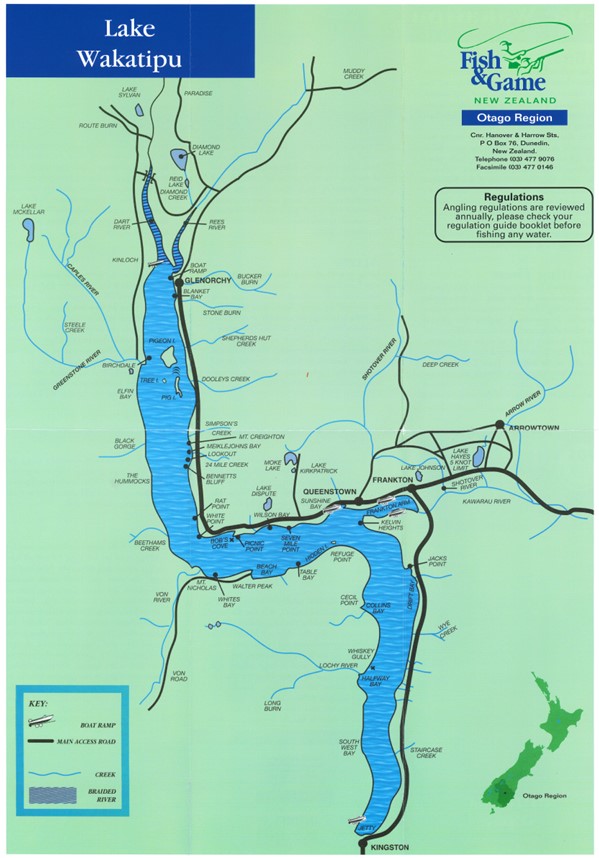Lake Wakatipu
Lake Wakatipu is 80km long and more than 300 metres deep. It's one of three big glacial lakes in the headwaters of the Clutha catchment, the others being lakes Wānaka and Hāwea.
Queenstown, on the shore of Lake Wakatipu, is an international tourist resort.
Lake Wakatipu is 'S' shaped with Queenstown located in the middle.
From Central Otago follow State Highway 6 through the Kawarau Gorge to Queenstown. From Southland follow State Highway 6 to Queenstown along the southern arm of the lake.
Caution is required at river mouths, which have unstable edges and strong currents. Surface lake water temperatures reach a maximum of about 10°C.
Access
Queenstown, on the shore of Lake Wakatipu, is an international tourist resort.
Lake Wakatipu is 'S' shaped with Queenstown located in the middle.
- From Central Otago follow State Highway 6 through the Kawarau Gorge to Queenstown. From Southland follow State Highway 6 to Queenstown along the southern arm of the lake.
Frankton Arm: Easy shore fishing access, including via Frankton Track and Kelvin Peninsula Trail.
- Queenstown to Glenorchy: Popular stream mouths include Twelve Mile Creek, Twenty Five Mile Creek and Buckler Burn.
- Glenorchy to Kinloch: The head of the lake, including the Dart and Rees rivers, can be accessed via unsealed road.
- Kinloch/Greenstone Station Road: Access along part of the northwestern shoreline and the Greenstone River mouth can be obtained via three dry weather fords.
- Queenstown to Kingston: State Highway 6 has shore fishing at stream mouths such as Wye Creek and Staircase Creek.
- Kingston: Easy fishing access from the beach and jetty.
- Southwest and northwest shorelines: Most can only be accessed by boat. Boat launching facilities (see map) are available at Kingston, Frankton Marina, Kelvin Heights, Queenstown (parking can be difficult at peak periods), Sunshine Bay and Glenorchy. Small boats can also be launched at Kinloch.
Please select image for larger view.
Methods
Brown and rainbow trout and landlocked Chinook salmon average about 1kg with occasional larger fish. About 70 percent of fish caught in the lake are brown trout.
The most successful methods are deep trolling with a leadline or downrigger around Glenorchy or Frankton Arm, or shore-based spinning near river and creek mouths.
Trolling
This method is the most successful way to catch landlocked salmon. Many anglers prefer Rapalas, although black Tobys, silver hexagon wobblers and Tasmanian devils, especially in traffic light patterns, and bright-coloured soft baits, are also popular. Salmon travel in large schools and are located close to shore when in pursuit of small fish in spring. During the summer months salmon are often caught in deep water, but they return to the large river mouths in autumn for the annual spawning run. Local experts often use a feathered lure 40-50cm in front of their main lure when fishing for salmon. The grey ghost is the best imitation of the salmon's natural prey. Anglers using leadlines generally fish with 3-4 colours out but go deeper in flat calm conditions. Harling with a feathered lure or downrigging provides excellent results on trout and salmon.
Spinning
Spinning is a successful method when applied effectively. Toby's, Rapalas, and King Cobra's are all commonly used lures though often in sizes too large. Small and bright Mepps spinners work well in shallow areas and in the large river mouths. Even the small creeks that enter the lake are worth investigating. For fun sport in the summer months fish the bush clad shorelines using a small plastic float half filled with water or sand (to facilitate your cast) and a large brown or green cicada dry fly imitation. Never bypass bottom structures along the lake edge such as large sunken logs and always be observant for wind lines off points that trap vegetation and other debris as these tend to attract hungry trout.
Flyfishing
Fly-fishing is the most successful method for catching trout yet less than 10% of all lake anglers utilise this technique. Most anglers target the river and small creek mouths throughout the year, preferring floating lines on nine-foot 6 weight rods. Sinking lines or fast sinking tips are sometimes used with streamer patterns when salmon are close to shore. Nymph fishing anglers prefer beaded Hare and Copper patterns, though large number 12 green stonefly patterns work well in the spring. Shoreline fishing and boat drifting in the summer months in areas with overhanging vegetation provide the best results with green cicada or yellow and/or green humpy patterns. Try fishing along the Frankton-Queenstown walkway if your time is limited.
